Landscape design professionals face a variety of complex challenges on every project. From mastering difficult terrains to site drainage problems, these challenges can put a damper on the success of your project.
Want to make tackling these challenges a little easier?
We’ve got you covered with this guide to understanding and addressing six common landscape design challenges. Plus we’ll give you some tips and tools for streamlining your project workflow.
Let’s get started.
6 Landscape Design Challenges and How Pros Solve Them
Each landscape design project is a puzzle where various elements need to fit together perfectly. Below, we discuss six common challenges you’ll run into and provide some PRO tips to help you navigate these issues effectively
1. Drainage Issues
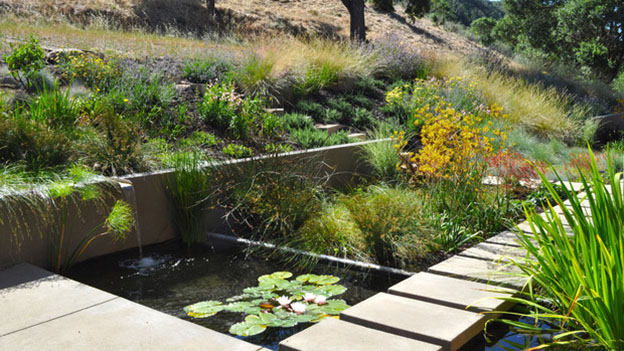
Landscape drainage problems can lead to serious issues, including water damage to buildings, dying plants, and unusable lawn areas. Addressing potential drainage issues starts with understanding the natural flow of water in the area:
Assessment: Carefully analyze the topography and identify low points where water accumulates. Identify where that water is coming from. Sometimes, simply redirecting downspouts or altering the grade can solve the problem.
Solutions: Use French drains, dry wells, and improved grading to manage excess water. Permeable paving also allows water to seep through and reduce runoff.
Rain Gardens & Swales: Utilize rain gardens or swales lined with water-tolerant plants to absorb and filter runoff. Do this and you’ve turned a problem into an attractive landscape feature.
PRO TIPS: Encourage clients to perform regular maintenance, like cleaning gutters and inspecting drainage systems. Doing this can prevent future drainage problems.
By incorporating drainage considerations into your initial designs you can avoid costly renovations down the road.
2. Steep Slopes & Hills
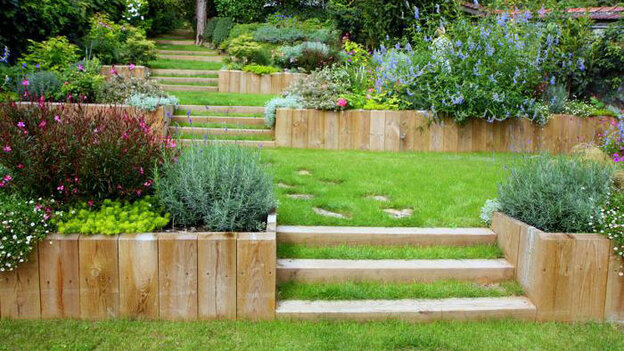
Steep slopes and hills, while challenging, offer design opportunities for stunning landscapes that flat terrains can’t match. However, they require careful planning and innovative solutions.
Terracing and Retaining Walls: Terracing creates usable flat areas on a slope, ideal for gardens or patios. Retaining walls can reduce soil erosion and add aesthetic value. Use materials that complement the home and surrounding landscape for a cohesive look.
Plant Selection and Placement: Plants on slopes need to combat erosion and be able to thrive on an incline. So go with deep-rooted plants like native grasses, shrubs, and certain trees to help stabilize the soil. Plant them in staggered rows for maximum erosion control.
Access and Safety: Steps, paths, and sturdy railings are essential for safe navigation around steep grades. Consider switchback paths instead of straight ones to reduce the path’s slope and reduce erosion.
PRO TIPS: Always plan for water flow on slopes since excess water can increase erosion risks. So plan to incorporate drainage solutions into slope designs for long-term stability.
3. Inhospitable Growing Conditions
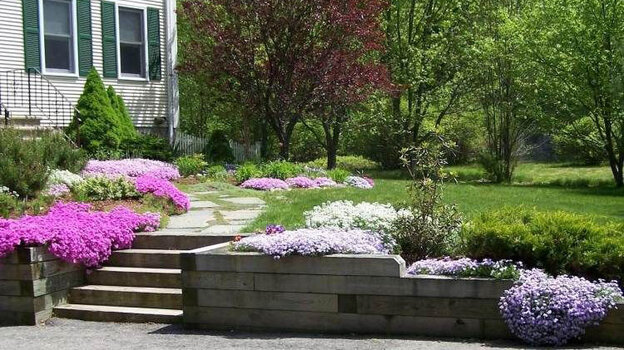
Sometimes the natural conditions of a site — such as poor soil, extreme pH levels, or hard ground — make it difficult to grow healthy plants. Here are some tips for adapting to this landscape design challenge.
Soil Improvement: Improving the soil with compost or other organic matter can provide more nutrients to help plants grow. In areas with extremely poor soil, consider raised beds or the extensive use of planters.
Choosing Hardy Plants: Some plants, particularly ones native to the area, are able to thrive in challenging conditions. Research and choose species that naturally grow in similar environments.
Mulching and Ground Cover: Use mulch to protect the soil from temperature extremes and retain moisture. Hardy ground cover can be an excellent solution for areas where other plants struggle to grow.
PRO TIPS: Soil testing can be invaluable. It allows you to understand your site’s specific needs and address them proactively, leading to a healthier, more vibrant landscape.
4. Weather Restrictions
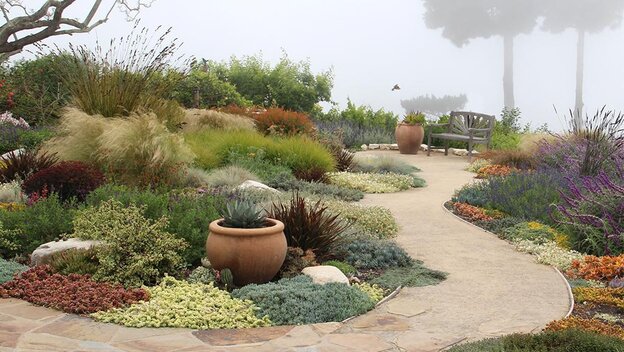
Landscaping in areas with extreme weather, like intense heat, cold, or wind, requires strategic planning and plant selection.
Understanding Microclimates: Different areas of your landscape may have varying exposures to sun, wind and temperature. Understanding these microclimates helps in selecting the right plants, and positioning them where they will thrive.
Drought-Tolerant Landscaping: In hot, dry climates, xeriscaping (landscaping that reduces or eliminates the need for irrigation) can be a smart approach. Use drought-tolerant plants and hardscaping elements like rocks and gravel to reduce water use.
Protection from Elements: In windy or cold areas, creating windbreaks with trees, shrubs, boulders or walls can protect more delicate plants. Cold frames and row covers (essentially mini greenhouses) can extend the growing season in colder climates.
Always consider the long-term effects of climate when designing a landscape. Investing in climate-appropriate landscaping leads to lower maintenance and higher sustainability.
5. Not Enough Sunlight

Shady landscapes can be particularly challenging, especially when trying to grow sun-loving plants. But the challenge of shade doesn’t have to be a limitation.
Understory Planting: Utilize the concept of understory planting (plants that thrive under the canopy of larger trees) for shaded areas. Many beautiful ferns, shrubs and flowering plants actually prefer indirect light.
Enhancing Light: Reflective materials, mirrors and light-colored surfaces can help brighten dark corners of the garden. You can also increase sunlight exposure with thoughtful pruning.
Creating Interest: In deeply shaded areas, focus on creating visual interest through textures, shapes and varying shades of green. Install site lighting to make these areas stand out in the evenings.
Embrace the cool, tranquil ambiance that shade gardens offer. With the right plant choices and design elements, these areas can become serene retreats within the landscape.
PRO TIP – Use a 3D design program like Contemporary Style Design to get a realistic look at the natural light in a landscaped area. Add all of your design elements, adjust the sun orientation and get photorealistic renderings with accurate natural lighting effects. You can even get renderings of the landscape in the evening with all the site lighting turned on.
Want to see how Contemporary Style Design can make that happen? It’s easier than you might think. Sign up today for the FREE version to see how it’s possible.
6. Lack of Privacy
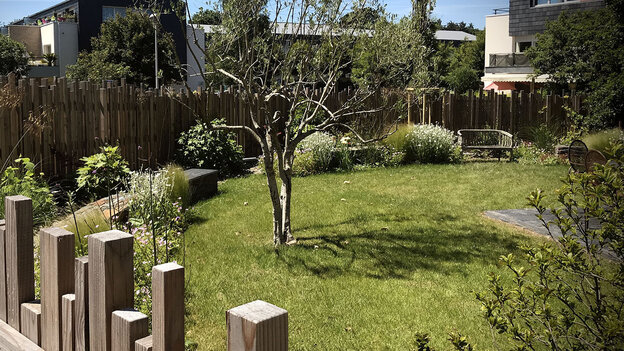
Sufficient privacy is a common challenge in many residential landscapes, especially in urban or suburban settings.
Strategic Planting: Tall hedges, bamboo screens or a combination of trees and shrubs can provide a green barrier from neighbors and street views. Try layering different plant heights for a more natural and effective screen.
Structural Elements: Fences, lattice and pergolas not only add privacy but also structure and interest to the garden. Combine these with climbing plants for a softer, more natural look.
Soundscapes: Consider incorporating elements like water features or rustling grasses to create a soundscape that enhances privacy and adds to the sensory experience of the garden.
PRO TIP – When planning for privacy, consider the growth and spread of plants over time. Ensure that your privacy solution is not just effective immediately but will remain functional as plants mature.
Using Terrain and Elevation Plans to Help With Landscape Design Challenges
Conquering landscape design challenges starts with a thorough understanding of your project site. Creating realistic renderings that let you visualize the final project is also a huge help in tackling challenging designs.
This is where Contemporary Style Design 3D home design software really shines. With intuitive terrain and elevation planning tools, you can:
- Visualize Challenging Areas: Create detailed 3D renderings to visualize how different elements will work within the landscape’s topography.
- Accurate Planning: Accurately measure and plan changes in elevation to streamline the design and implementation of terraces, retaining walls, slopes, and drainage.
- Dynamic Adaptation: Quickly adjust your designs based on client feedback and unforeseen site constraints. This helps you and your project stay flexible and focused on getting your clients what they need.
Sign up today for the FREE version and see how Contemporary Style Design can help you tackle your next landscape project…and whatever challenges that may come with it!




